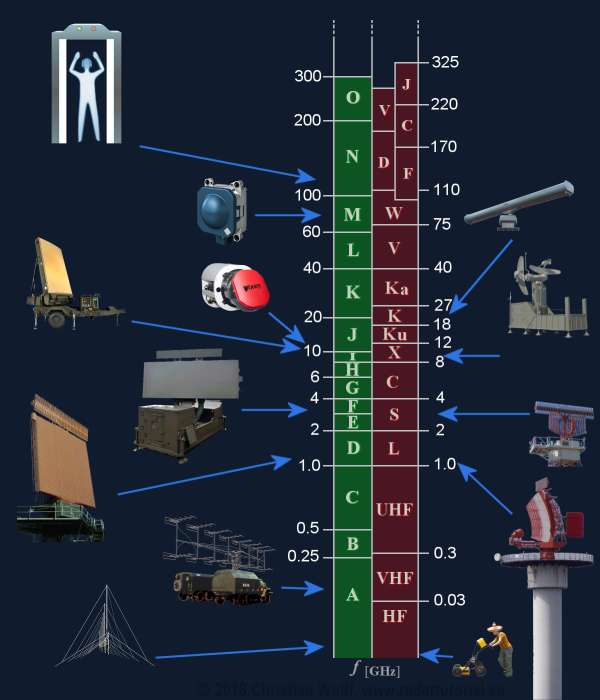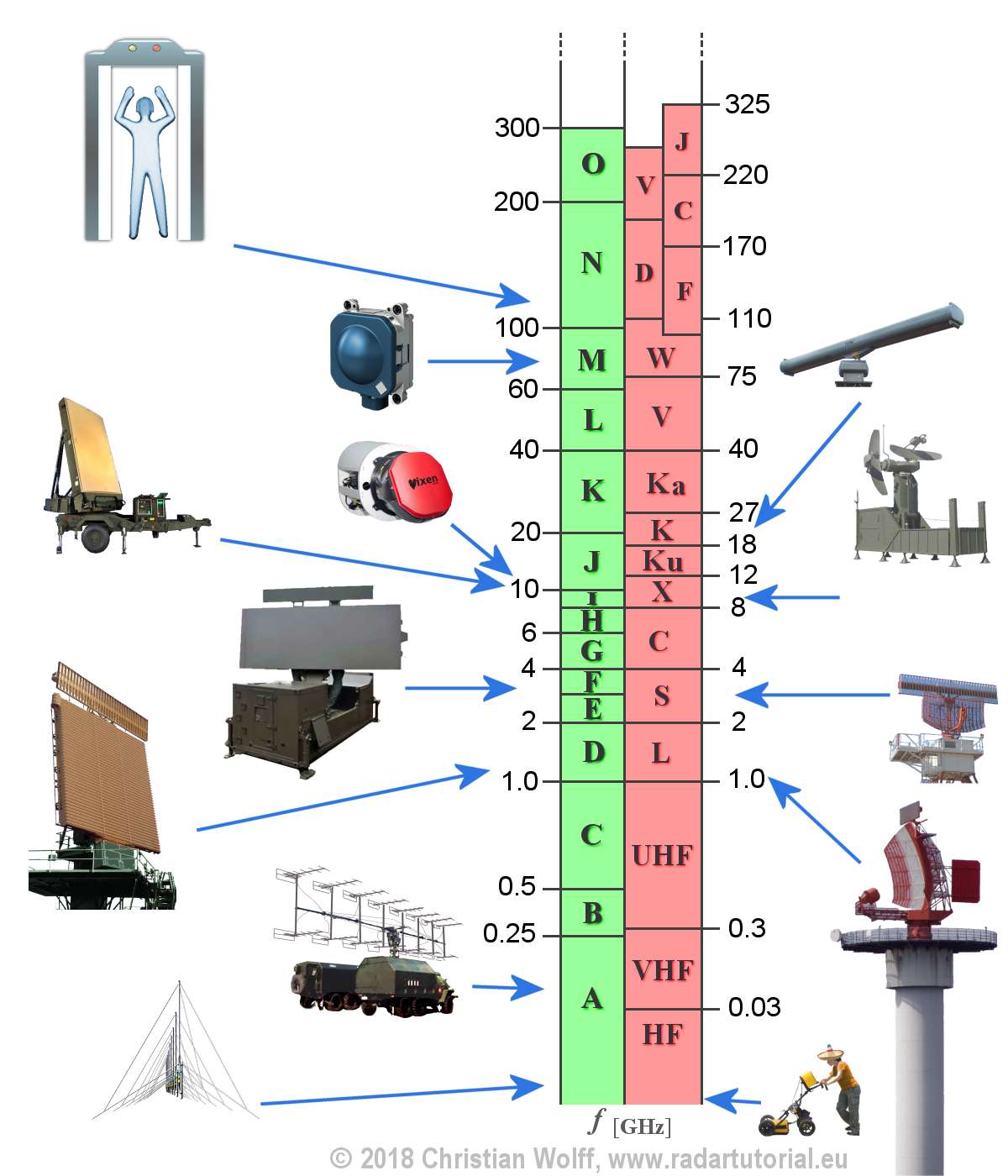Waves and Frequency Ranges
The spectrum of electromagnetic waves has frequencies up to 1024 Hz. This very large range is subdivided into different subranges due to different physical properties. The subdivision of the frequencies into the different ranges was previously measured according to criteria that were historically developed and are now obsolete, and so a new classification of the frequency bands was created. This new classification could not yet fully established internationally. The traditional frequency band designation is often still used in the literature. In NATO the new subdivision is used.
The following graphic shows an overview:

Figure 1: Waves and frequency ranges used by radar.

Figure 1: Waves and frequency ranges used by radar.
Therefore currently there are two valid designation systems for frequency bands which are compared in Figure 1. The IEEEInstitute of Electrical and Electronics Engineers (IEEE) favors the designation system, which originated historically and whose intentionally unsystematic distribution of the letters to the band designation partly originates from the time of the 2nd World War. Its selection was initially intended to keep the frequencies used secret.
A newer frequency band classification is used within NATONorth Atlantic Treaty Organization (NATO). Its band boundaries are adapted to the technologies and measurement possibilities in the different frequency ranges. They are almost logarithmically distributed and the system is open to the high frequencies. In this system, further frequency bands up to the terahertz range can easily be defined in the future. This designation system is also of military origin and is a band division for the electronic war, in which radar equipment finally occupies an essential place.
Since an assignment into the new frequency bands is not always possible without the exact frequency being known, I made use of the traditional band names without comment where they were mentioned in the manufacturer's publications. But be careful! In Germany, for example, companies still use old band names. Radar sets of a so-called “C-band family” operate with certainty in the new G-band, but radar sets with the letter “L” in the designator (e.g. SMART-L) no longer operate in the L-band but in the D-band.
The frequencies of radar sets today range from about 5 megahertz to about 130 gigahertz (130,000,000,000 oscillations per second!). However, certain frequencies are also preferred for certain radar applications. Very long-range radar systems usually operate at lower frequencies below and including the D-band. Air traffic control radars at an airport operate below 3 GHz (ASR) or below 10 GHz (PAR).

Figure 2: some radars and its frequency band

Figure 2: some radars and its frequency band

Radar
Radar
Figure 2: some radars and its frequency band
A- and B- Band (HF- and VHF- Radar)
These radar bands below 300 MHz have a long tradition, as the first radar sets were developed here before and during the 2nd World War. The frequency range corresponded to the high-frequency technologies mastered at that time. Later, they were used for early warning radars of extremely long-range, so-called Over The Horizont (OTH) radars. Since the accuracy of angle determination and the angular resolution depends on the ratio of wavelength to antenna size, these radars cannot meet high accuracy requirements. The antennas of these radar sets are nevertheless extremely large and can even be several kilometers long. Here special abnormal propagation conditions act, which increase the range of the radar again at the expense of the accuracy. Since these frequency bands are densely occupied by communication radio services, the bandwidth of these radar sets is relatively small.
These frequency bands are currently experiencing a comeback, while the actually used Stealth technologies don't have the desired effect at extremely low frequencies.
C- Band (UHF- Radar)
For this frequency band (300 MHz to 1 GHz), specialized radar sets have been developed which are used as military early warning radar, for example for the Medium Extended Air Defense System (MEADS), or as wind profilers in weather observation. These frequencies are damped only very slightly by weather phenomena and thus allow a long-range. Newer methods, so-called ultrawideband radars, transmit with very low pulse power from the A to the C band and are mostly used for technical material investigation or partly in archaeology as Ground Penetrating Radar (GPR)
D- Band (L-Band Radar)
This range is ideally suited for modern long-range air surveillance radars up to a range of 250 nautical miles (≈400 km). Relatively low interference from civil radio communication services enables broadband radiation with very high power. They transmit pulses with high power, wide bandwidth and an intrapulse modulation to achieve even longer ranges. Due to the curvature of the earth, however, the range that can be practically achieved with these radar sets is much smaller at low altitudes, since these targets are then obscured by the radar horizon.
In this frequency band the En-Route Radars or Air Route Surveillance Radars (ARSR) work for air traffic control. In conjunction with a Monopulse Secondary Surveillance Radar (MSSR), these radars operate with a relatively large, slowly rotating antenna. (L-band: like large antenna and long-range). The designator L-Band is good as mnemonic rhyme as large antenna or long range.
E/F-Band (S-Band Radar)
In the frequency band from 2 to 4 GHz the atmospheric attenuation is higher than in the D-band. Radar sets require a much higher pulse power to achieve long-ranges. An example is the older one military Medium Power Radar (MPR) with up to 20 MW pulse power. In this frequency band, considerable impairments due to weather phenomena are already beginning to occur. Therefore a couple of weather radars work in E/F-Band but more in subtropic and tropic climatic conditions, because here the radar can see beyond a severe storm.
Special Airport Surveillance Radars (ASR) are used at airports to detect and display the position of aircraft in the terminal area with a medium range up to 50…60 NM (≈100 km). An ASR detects aircraft position and weather conditions in the vicinity of civilian and military airfields. The designator S-Band is good as mnemonic rhyme as smaller antenna or shorter range (contrary to L-Band).
G- Band (C-Band Radar)
For this frequency band mobile military battlefield radars with short and medium range are used. The antennas are small enough to be quickly installed with high precision for weapon control. The influence of weather phenomena is very large, which is why military radar sets are usually equipped with antennas with circular polarization. In this frequency range, most weather radars are also used for moderate climates.
I/J- Band (X- and Ku- Band Radars)
Between 8 and 12 GHz, the ratio of wavelength to antenna size has a more favorable value. With relatively small antennas, sufficient angular accuracy can be achieved, which favours military use as airborne radar. On the other hand, the antennas of missile control radar systems, which are very large relative to the wavelength, are still handy enough to be considered as deployable.
This frequency band is mainly used in civil and military applications for maritime navigation radar systems. Small cheap and fast rotating antennas offer sufficient ranges with very good precision. The antennas can be constructed as simple slot radiators or patch antennas.
This frequency band is also popular for space borne or airborne imaging radars based on Synthetic Aperture Radar (SAR) both for military electronic intelligence and civil geographic mapping. A special application of the Inverse Synthetic Aperture Radar (ISAR) is the monitoring of the oceans to prevent environmental pollution.
K- Band (K- and Ka- Band Radars)
As the emitted frequency increases, the attenuation in the atmosphere increases but the possible accuracy and range resolution increases too. Large ranges can no longer be achieved. Radar applications in this frequency range are, for example, airfield surveillance radar, also known as Surface Movement Radar (SMR) or (as part of) Airport Surface Detection Equipment (ASDE). With extremely short pulses of a few nanoseconds, an excellent range resolution is achieved so that the contours of aircraft and vehicles can be seen on the display.
V-Band
Due to molecular scattering of the atmosphere the electromagnetic waves suffer a very strong attenuation. Radar applications are limited to a range of a few ten meters.
W-Band
Two phenomena of atmospheric attenuation can be observed here. A maximum of attenuation at about 75 GHz and a relative minimum at about 96 GHz. Both frequencies are used practically. At about 75 to 76 GHz, short-range radar sets are used in automotive engineering as parking aids, brake assist systems and automatic accident avoidance. This high attenuation through molecular scattering (here through the oxygen molecule O2) prevents mutual interference through mass use of these radar sets.
There are radar sets operating at 96 to 98 GHz as laboratory equipments yet. These applications give a preview for a use of radar in extremely higher frequencies as 100 GHz.
N-Band
In the 122 GHz range there is another ISM band for measurement applications. Since in high-frequency technology the Terahertz range is defined from 100 GHz = 0,1 THz to 300 GHz, the industry offers radar modules for this frequency range as “Terahertz radar”. These Terahertz radar modules are used, for example, in so-called full-body scanners. Full-body scanners take advantage of the fact that although these Terahertz frequencies can easily penetrate dry and non-conductive substances, they cannot penetrate the skin deeper than just a few millimeters due to the moisture of the human skin.
In Merill Skolniks “Radar Handbook” (3rd edition) the author pleads for the older IEEE- Standard Letter Designation for Radar-Frequency Bands (IEEE-Std. 521-2002). These letter designations (as shown as in the red scale of Figure 1) were originally selected to describe the radar bands as used in World War II. But the usable frequencies are higher than 110 GHz now - There are phase-controlled generators up to 270 GHz, powerful transmitters up to 350 GHz today. Sooner or later these frequencies will be used for radars too. In parallel, the use of UWB radar is beyond the boundaries of traditional radar frequency bands.
The different designations for Radar-Frequency Bands are very confusing. This is no problem for radar engineers or technicians. These skilled persons can handle these different bands, frequencies, and wavelengths. But they are not responsible for procurement logistics, e.g. for the purchasing of maintenance and measurement tools or even to buy a new one radar. Unfortunately, the management of logistics has graduated in business sciences mostly. Therefore, they will have a problem with the confusing band designators. The problem is now to assert, that a frequency generator for I and J-Band serves an X- and Ku-Band Radar and the D-Band Jammer interferes an L-Band Radar.
UWB-radars use a very wide frequency range, beyond the strict borders of the classic frequency bands. What is better to say: This one e.g. UWB-radar uses a frequency range from E to H-Band, or it uses the same frequencies from higher S-band to lover X-Band?
But so long the offered radar sets will be named with the old frequency-band designators by the radar manufacturers, so long the IEEE will declare, that the new frequency bands: “…are not consistent with radar practice and shall not be used to describe radar frequency bands.” I think it's merely a matter of time, and even the IEEE will change its opinion. Remember: It is not a long time ago, even as the whole metric system of units of measurement was considered inappropriate within the IEEE.
